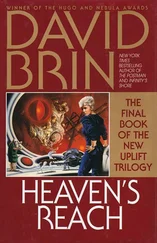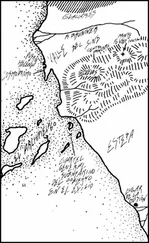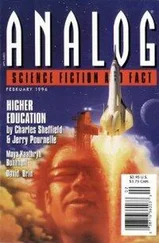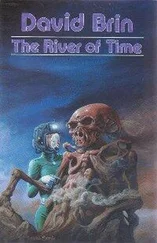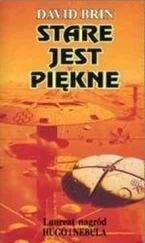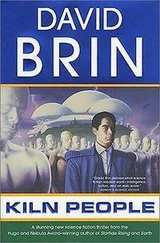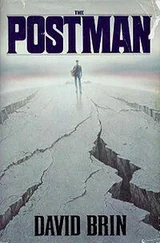“… classic symptoms of guilt abstraction, used by the subject to disguise early childhood traumas…” one correspondent from Peking had written. Another in Djakarta commented, “Lustig’s absurd hints that Hawking’s dissipation model might be wrong mesh perfectly with the shame and humiliation he must have felt after Iquitos…”
Alex wished his Net clipping service were less efficient, sparing him all the amateur psychoanalyses. Still, he had made himself read them because of something his grandmother once told him.
A hallmark of sanity, Alex, is the courage to face even unpleasant points of view.
How ironic then. Here he was, vindicated in a way he could never have imagined. He now had proof positive that the standard model of micro black holes was flawed… that he had been on the right path with his own theories.
Right and wrong, in the best combination of ways.
Then why can’t I leave this cave ? he wondered. Why do I feel it isn’t over yet ?
“Hey, you stupid pakeha bastard!” A booming voice ricocheted off the limestone walls. “Lustig! You promised to get drunk with us tonight! Tama meamea , is this any way to celebrate?”
Alex had the misfortune to be looking up when George Hutton switched on the lights. His world, formerly confined to the dim pool of the holo tank, suddenly expanded to fill the cavern-lab Hutton’s wealth had carved under the ancient rock.
Alex’s blinking eyes focused first on the thumper, a shining rod two meters in diameter and more than ten long, caged to a universal bearing in a bowl excavation larger than some lunar craters. It resembled the work of some mad telescope maker who had neglected to make his instrument hollow, crafting it, instead, of perfect, superconducting crystal.
The gleaming cylinder pointed a few degrees off vertical, just as they had left it after that final bracketing run. Banks of instruments surrounded the gravity antenna, along with ankle-deep layers of paper, shredded by the ecstatic technicians when the good news had finally been confirmed.
Beyond the thumper, a flight of steps led upward to where George Hutton stood, waving a bottle and grinning. “You disappoint me, fellow,” the broad-shouldered billionaire said, sauntering downstairs unevenly. “I planned getting you so pissed you’d spend the night with my cousin’s poaka of a daughter.”
Alex smiled. If that was what George wanted him to do, he was bound to comply. Without Hutton’s influence he’d never have been able to sneak into New Zealand incognito. There’d have been no long hard search through the awesome complexity of the Earth’s interior, improvising and inventing new technologies to hunt a minuscule monster. Worst of all, Alex might have gone to his grave never knowing what his creation was up to down below — if it was quietly dissipating or, perhaps, proceeding at a leisurely pace to devour the world.
At first, sighting it several days ago on a graviscan display had seemed to confirm their worst fears. The nightmare, reified.
Then, to everyone’s relief and astonishment, hard data seemed to point another way. Apparently the thing was dying… evaporating more mass and energy into the Earth’s interior than it sucked in through its narrow event horizon.
True, it was thinning much more slowly than the obsolete standard models predicted. But in a few months, nevertheless, it would be no more!
I really should celebrate with the others , Alex thought. I should put aside my last suspicions, crawl into any bottle George offers me, and find out what a poaka is .
Alex tried to stand, but found he couldn’t move. His eyes were drawn back to the purple dot, circling the innermost colored layer.
He felt a large presence nearby. George.
“What is it, friend? You haven’t found an error, have you? It is…”
Alex caught Hutton’s sudden concern, “Oh, it’s dissipating all right. And now…” He paused. “Now I think I know why. Here, take a look.”
With a word he banished the model of the Earth, replacing it with a schematic drawn in lambent blue. Reddish sparkles flashed at the rim of the object now centered in the tank. They swept toward a central point like beads caught in water, swirling down a drain.
“This is what I thought I was making, back when His Excellency persuaded me to build a singularity for the Iquitos plant. A standard Kerr-Prestwich black hole.”
Hutton took a stool next to Alex and watched with those deceptive brown eyes. One might guess he was a simple laborer, not one of Australasia’s wealthiest men.
The image in the tank looked like a rubber sheet that had been stretched taut and heated, and then had a small, heavy weight dropped onto it. The resulting funnel had finite width and depth in the display, but both men knew that the real thing — the hole in space it represented — had no bottom at all. The reddish dots represented bits of matter drawn in by gravitational tides, caught in a swirling disk. The disk brightened as more matter fell, until a ring of fierce brightness burned near the funnel’s lip. Below this came a sudden cutoff within which only pitch blackness reigned.
Nothing escapes from inside a black hole’s event horizon. At least, there’s no direct escape .
Alex glanced at George. “Cosmologists say many singularities like this must have been created when the universe began. If so, only the biggest survive today. Smaller ones evaporated long ago, as predicted in the 1970s by Stephen Hawking. A simple singularity — even with charge and rotation — has to be extremely heavy to be stable… to pull in matter faster than it’s lost by vacuum emission.”
[INSERT IMAGE HERE]
He pointed to the outskirts of the depression, where bright white pinpoints flashed independently of the hot ring of accreting material.
“Some distance out, the tight stress-energy of infolding gravity causes spontaneous pair production… ripping particle-antiparticle twins — an electron and a positron, for instance — out of the vacuum itself. It isn’t exactly getting something from nothing, since each little genesis costs the singularity some field energy. And that’s debited to its mass.”
The sparkles formed a halo of brilliance — creation in the raw.
[INSERT IMAGE HERE]
“Generally, one newborn particle falls inward and the other escapes, resulting in a steady weight loss. A tiny hole like this one can’t pull in new matter fast enough to make up the difference. To prevent dissipation you have to feed it.”
“As you did with your ion gun, in Peru.”
“Right. It cost a lot of power to make the singularity in the first place, even using my special cavitron recipe. It took even more to keep the thing levitated and fed. But the accretion disk gave off incredible heat.” Alex felt briefly wistful. “Even the prototype was cheaper, more efficient than hydro power.”
“But then you started having doubts,” George prompted.
“Yeah. The system was too efficient, you see. It didn’t need much feeding at all. So I toyed with some crazy notions… and came up with this.”
A new schematic replaced the funnel. Now it was as if a heavy loop of wire had sunk into the rubber sheet. Still unfathomably deep, the depression now circled on itself.
Again, reddish bits of matter swept into the cavity, heating as they fell. And again, sparkles told of vacuum pair production — the singularity repaying mass into space.
“This is something people talked about even back in TwenCen,” Alex said. “It’s a cosmic string .”
“I’ve heard of them.” George’s dark features showed fascination. “They’re like black holes. Also supposed to be left over from that explosion you pakeha say started everything — the Big Bang.”
Читать дальше



